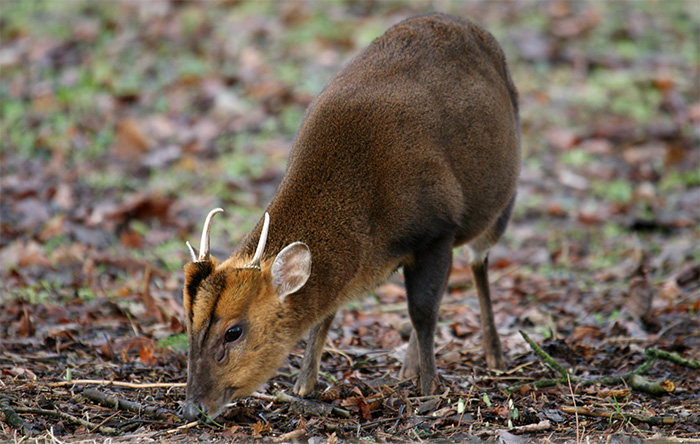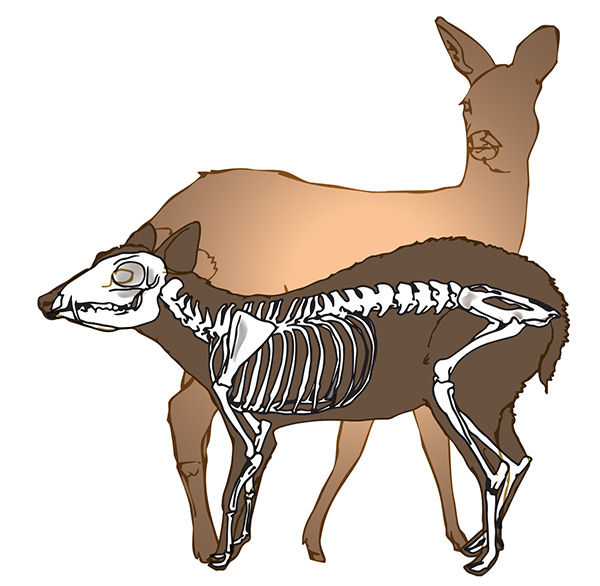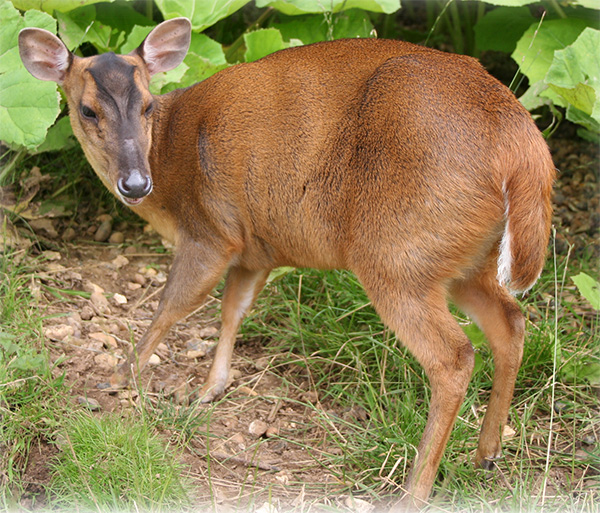Aim
The aim of this guide is to assist in the identification of muntjac deer, specifically in comparison to roe deer, and provide guidance on control of the species in Scotland.

with grateful acknowledgement to BDS Library
Invasive Non-Native Status
Muntjac deer are classified as invasive non-native species under the Wildlife & Natural Environment Act (Scotland) 2011.
- It is illegal to release muntjac deer into the wild.
- A licence is needed to keep muntjac deer in captivity
Recognition

- Small, stocky, russet brown in summer, grey brown in winter
- Very large facial (sub orbital) glands that are obvious when open and located below the eyes
- Haunches higher than shoulders, giving a hunched appearance
- Fairly wide brown tail with white underside, which is held erect when disturbed.
- Bucks:
- Long pedicles, short antlers and visible upper canines
- Ginger forehead with pronounced black lines running to the pedicles
- Antlers short (up to 10cm) but on long pedicles, usually unbranched, but very short brow tine occasionally found on old bucks
- Adult size: 10 to 18kg; 44 to 52cm at shoulder
- Life span: exceptionally, up to 16 years.
- Does:
- Ginger forehead with pronounced dark diamond shape
- Adult size: 9 to 16kg; 43 to 52cm at shoulder
- Life span: exceptionally, up to 19 years.
Habitat

Measurement to shoulder: a Roe deer is typically 73cms while a Muntjac is 52 cms
Favour deciduous or coniferous forests, preferably with diverse under-storey. Also found in scrub and over-grown gardens in urban areas.
Social Organisation
Generally solitary, or found in pairs (doe and fawn, or buck with doe), although pair-bonding does not occur. Bucks defend small exclusive territories against other bucks, whereas does’ territories overlap each other and with several bucks. Bucks may fight for access to does but remain unusually tolerant of subordinate males within their vicinity.
Vocalisation
A common name for muntjac is “barking deer” resulting from the repeated , loud bark given under a number of circumstances. An alarmed muntjac may scream, whereas maternal does and fawns squeak.
Breeding
In contrast to all other deer species of deer in Britain, muntjac do not have a defined breeding season (rut). Muntjac are capable of breeding at 8 months old and breed all year round, with does able to conceive again within days of giving birth. After a gestation period of 7 months the doe gives birth to a single fawn.

with grateful acknowledgement to BDS Library
with grateful acknowledgement to BDS Library
Activity
Muntjac are active throughout the 24-hour period but make more use of open spaces during the hours of darkness where populations experience frequent disturbance. Peak times of activity are at dawn and dusk. After feeding, long periods are spent lying down and ruminating.
Control
- Muntjac can be hard to see, even in minimal cover and are often very mobile
- Patience, predicting where the animal will appear next and learning how to stop a questing animal are key
- Baiting (e.g. with apples or carrots) may be effective for individual animals
- Heavily pregnant does will have independent fawns and are a more humane target. Yearling does will also not have a fawn at foot. Unintentionally orphaned fawns will often return to their mother and should be shot.
